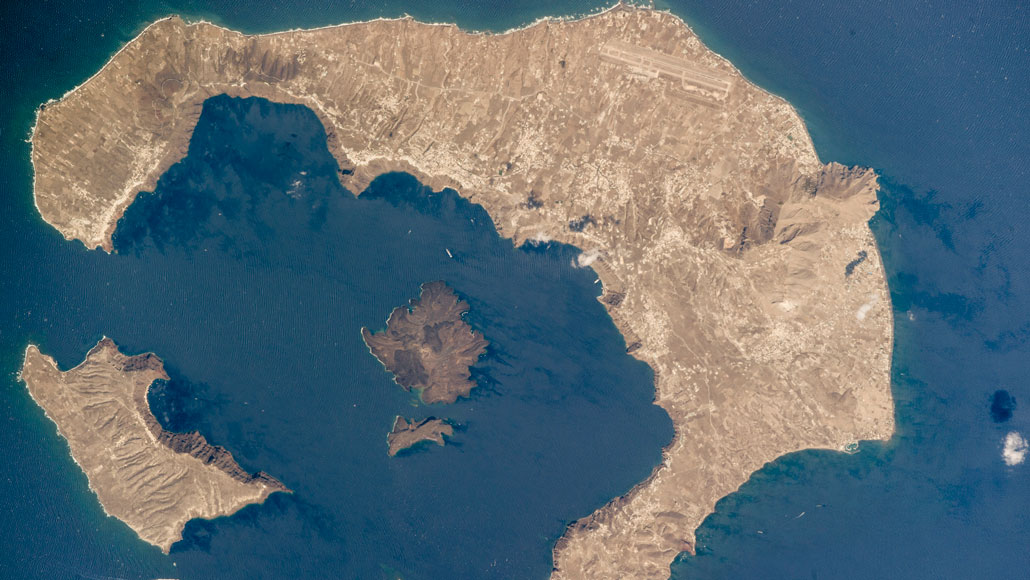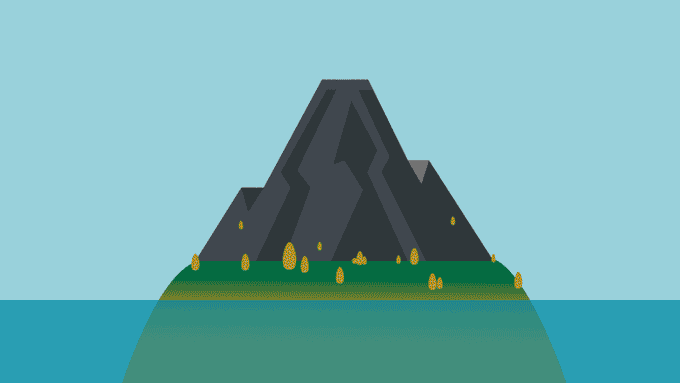Greece’s Santorini volcano erupts more when the sea level drops
Data showing this association go back at least 360,000 years

Sea level influences eruptions from the partially-drowned Santorini volcano in Greece (pictured). Lower sea levels are linked to more eruptions.
NASA Earth Observatory
Share this:
- Share via email (Opens in new window) Email
- Click to share on Facebook (Opens in new window) Facebook
- Click to share on X (Opens in new window) X
- Click to share on Pinterest (Opens in new window) Pinterest
- Click to share on Reddit (Opens in new window) Reddit
- Share to Google Classroom (Opens in new window) Google Classroom
- Click to print (Opens in new window) Print
When sea level drops, the Santorini volcano gets ready to rumble.
Santorini is an island volcano in Greece. It consists of a ring of islands around the volcano’s central tip. The whole volcano used to be above water. But it caved in after a violent eruption some 3,600 years ago. That eruption might have inspired the legend of the sunken city of Atlantis.
Researchers wanted to better understand what makes this volcano blow its top. So they compared its past activity with historic sea levels. And when the sea level dips 40 meters (131 feet) below its present-day level, Santorini has a fit of eruptions. The volcano stays quiet when sea levels are higher. The team shared its findings August 2 in Nature Geoscience.
Sea level probably affects other volcanoes too, the researchers say. That’s because most volcanoes are in or near oceans.
“It’s hard to see why a coastal or island volcano would not be affected by sea level,” says Iain Stewart. He’s a geoscientist who wasn’t involved in the study. He works at the Royal Scientific Society of Jordan in Amman. Accounting for sea level could make eruption forecasts more accurate, the paper’s authors say.
Simulating Santorini
Christopher Satow led the new study. He’s a physical geographer at Oxford Brookes University. That’s in England. Satow’s team first created a computer model of the volcano. That simulation included the chamber of magma that feeds Santorini’s eruptions. It lies about four kilometers (2.5 miles) below the volcano’s surface.
In the simulation, the crust above the magma chamber cracked as the sea level dropped. (Lower sea level meant less water pressing down on the crust to hold it together.) The crust started to break when sea level fell 40 meters below its current level.
“That gives an opportunity for the magma that’s stored under the volcano to move up through these fractures,” Satow says. It took about 13,000 years for the magma to reach the surface and cause eruptions. When the sea level again rose, it took about 11,000 years for the cracks to close and eruptions to end.

Real-world eruptions
Satow’s team wanted to know whether the computer simulates what happens in real life. Rock layers on the islands of Santorini contain clues about past eruptions. Seafloor sediments hold evidence of past sea levels. The team compared the volcano’s eruption history to those sea-level records. Those data go back 360,000 years.
Santorini has had 211 well-dated eruptions over that time. Sea levels were low when much of Earth’s water was frozen in glaciers during ice ages. All but three eruptions happened during periods of low sea level. That matches expectations from the computer model.
Santorini is now due to enter a quiet period. The last time the sea level was last 40 meters below today’s level was about 11,000 years ago. And sea level is continuing to rise due to climate change. So cracks in the crust above Santorini’s magma chamber should be closing.
But a future violent eruption isn’t impossible. After all, a few of Santorini’s eruptions still occurred amidst high sea levels.
Other volcanoes
The effect of sea level on Santorini is “really intriguing,” says Emilie Hooft. She’s a geophysicist at the University of Oregon in Eugene. She isn’t totally surprised by what Satow’s group found. “Other studies have shown that volcanoes are sensitive to changes in their stress,” she says.
For instance, after overlying glaciers have melted, volcanoes in Iceland have shown an uptick in eruptions. The reason is similar to why lower sea levels awaken Santorini. A glacier’s retreat will reduce the weight above Earth’s crust at Iceland’s volcanoes. That allows more underground magma to rise to the surface.
Sea level likely affects volcanoes around the world, Satow says. But how much it does will likely vary. “Some will be very sensitive to sea-level changes,” he says. “For others, there will be almost no impact.” Eruptions depend on many factors. One is the depth of the magma chamber that feeds a volcano. Another is the quality of the crust above that chamber.
But if sea level impacts any volcano in or near the ocean, “you’d expect all these volcanoes to be in sync,” Satow says. “Which would be incredible.”







